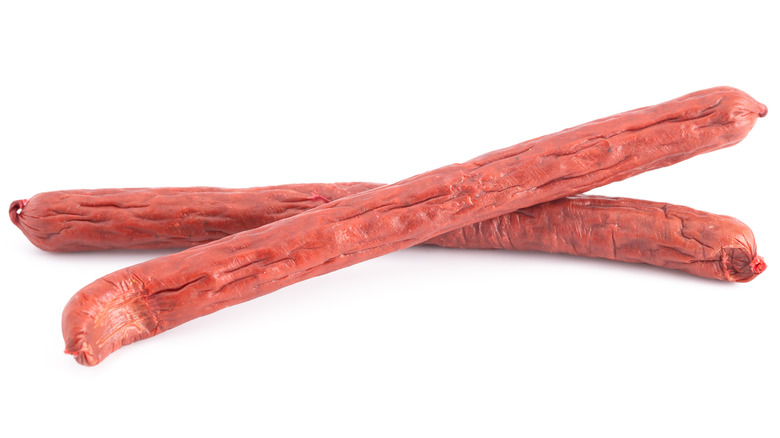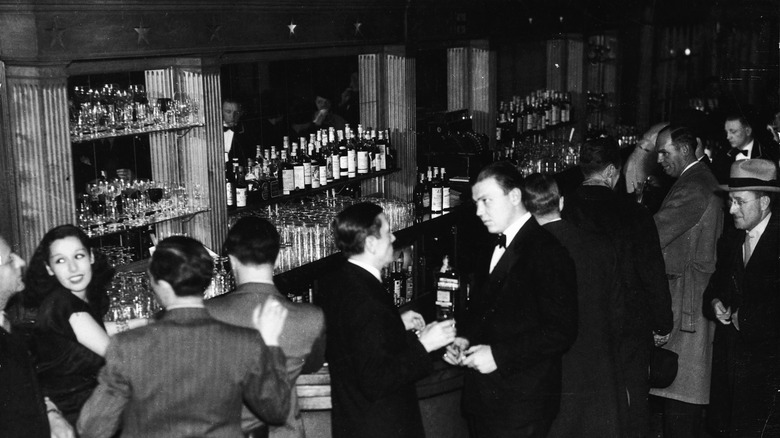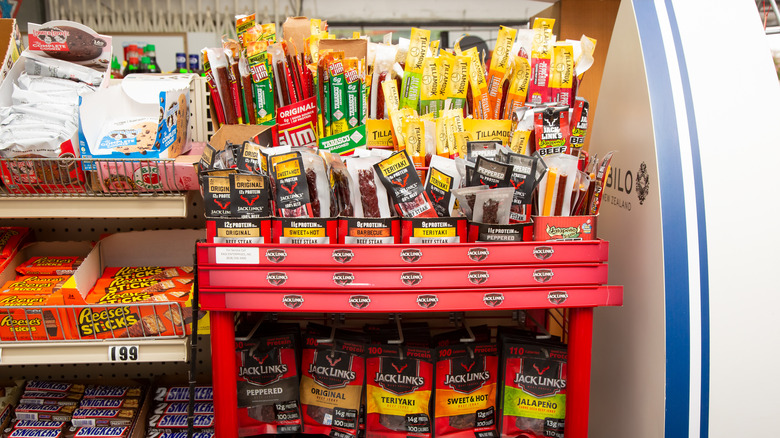Why Slim Jims Were Originally Sold As Bar Food
When Slim Jim founder Adolph Levis began his career, he was just sixteen years old and a high school dropout. In 1929, at the outset of the Great Depression, Levis left school to begin hocking condiments, relishes, cabbages, and pickled meats to local bars and delis to help make ends meet, according to Mel Magazine. Levis turned out to have a keen eye for business, in no small part because he was attentive to his customers. While he sold a number of meat products, including pickled pigs' feet, he eventually noticed that pepperoni seemed to sell much better than just about anything else.
Bar owners would quickly run out of the pepperoni they purchased from Levis. However, there was one major problem with the pepperoni logs that tavern patrons liked to snack on. They were big, inconvenient, and messy to eat, not to mention the fact that they took a long time to cure and produce, making them hard to keep on the counter, according to Thrillist. So Levis set out to improve upon the popular meat snack.
Adolph Levis wanted to create a better bar snack
Levis decided to partner with his brother-in-law, Joseph Cherry, to create a smaller, cleaner, more convenient, and all-around better pepperoni snack. In the early 1940s, the pair hired a meat packer to help innovate a new slim stick of dried, spiced meat that only took three months to cure. To keep fresh, these more manageable meat rods were stored in small vats of vinegar behind bar counters, where they were advertised as "less than a meal and more than a snack," according to The Dispatch. They were a hit with bar patrons, who preferred the small spiced sticks to large, unwieldy pepperoni logs.
Initially, the entrepreneurs named the meat stick "Penn Rose," after Levis' home state of Pennsylvania and his wife's name, details Mel Magazine. However, the name wasn't a big draw for customers. To better promote the new product, Levis and Cherry decided they needed a mascot, and so "Slim Jim" was born. The name highlighted the fact that the product was slimmer than other sausage snacks that were being sold at the time. Levis devised an elegant, tuxedo- and top-hat-clad fellow named "Slim Jim" to accompany the new name, according to the New York Times, and marketed the meat on ashtrays not just as a more refined bar snack but as a way to elevate one's drinking experience.
Slim Jims weren't individually wrapped until the 1950s
Soon, Levis and Cherry's business had become successful enough for them to launch their own food company, the New York Times recalls. The pair opened Cherry-Levis Food Products and continued to sell the sophisticated snack food in bars throughout the 1950s. Eventually, Levis decided to begin packaging the meat in individual cellophane wrappers, making the snack much more convenient and easily transportable than ever before. As a result, it was able to move out of bars and into convenience stores and grocery shops. The success allowed Levis to sell his company to General Mills in 1967, and the rest is history.
Today, the Slim Jim can be found in just about every checkout line and gas station across the country, and it is a favorite grab-and-go snack for folks on the road. In fact, Slim Jim's public relations manager Dan Skinner even explained to Thrillist that Slim Jim sales increase during the spring and summer months, when more people are apt to embark on long trips. But while the Slim Jim might now be an iconic road trip snack, its roots are still firmly planted on a barstool.


